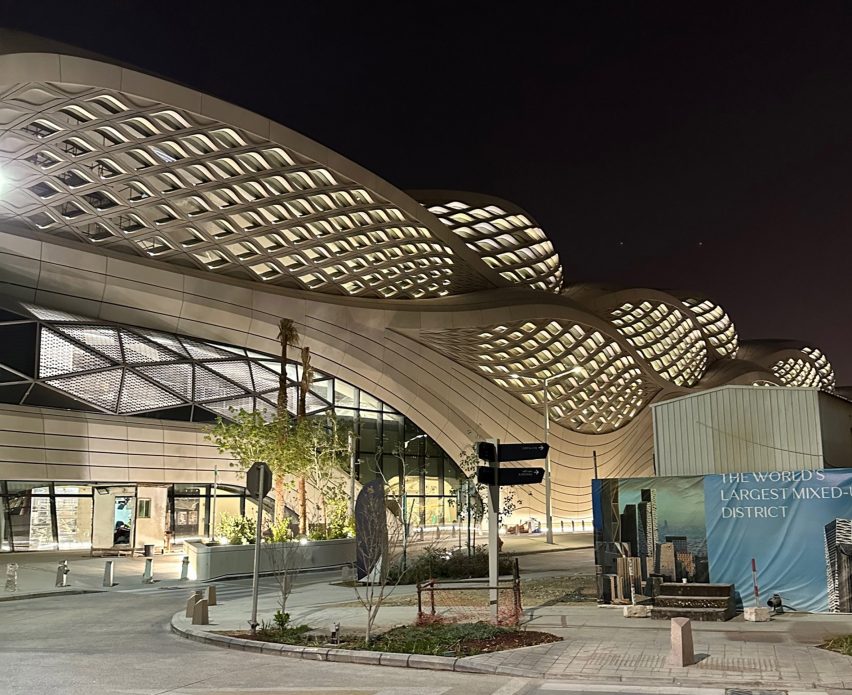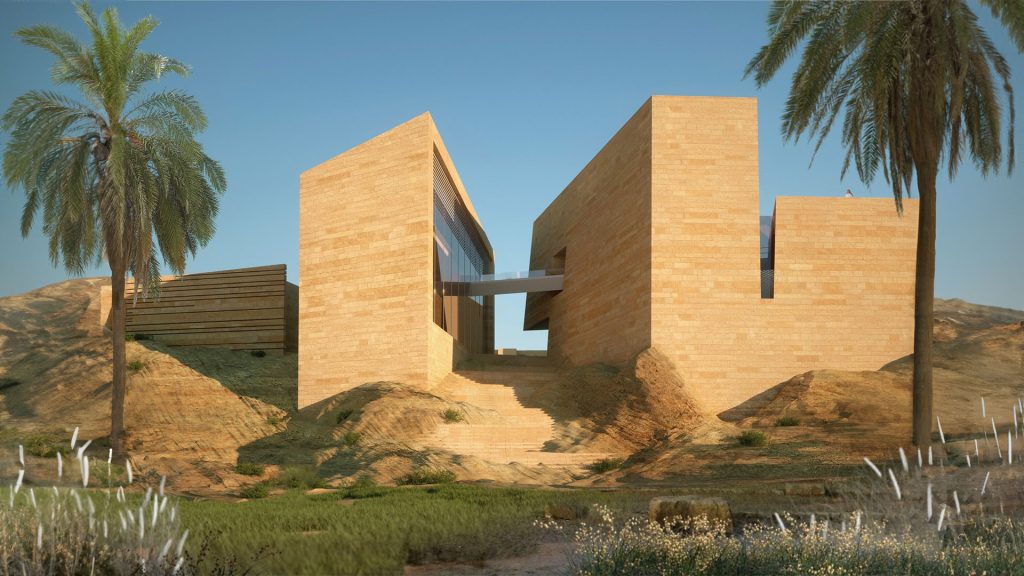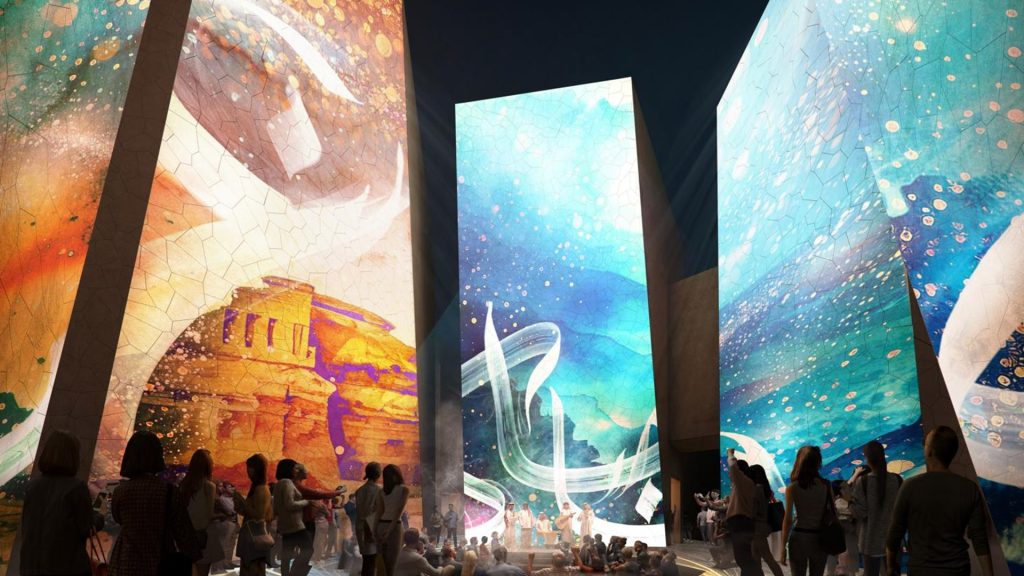Introduction
Embark on a visual odyssey with our blog, ‘Riyadh Metro Station Design: A Symbol of Saudi Arabia’s Vision 2030 Plan’. Uncover the architectural marvels shaping the King Abdullah Financial District Metro Station, a beacon of innovation and a tangible manifestation of Saudi Arabia’s commitment to a diversified, forward-looking future.
Table of Contents
Architectural Marvel of Riyadh Metro
The Riyadh station emerges as a striking testament to architectural innovation, embodying the visionary prowess of Zaha Hadid Architects. Spanning 45,000 square meters, the station is a multidimensional marvel slated to become one of Riyadh’s largest transit hubs. Its standout feature lies in its role as an interchange connecting three metro lines and seamlessly integrating with the King Abdullah Financial District monorail, facilitating efficient transit across the bustling city.
Designed by the late Zaha Hadid and Patrik Schumacher, the station’s exterior is a symphony of steel framework, wrapping six platforms in a geometric dance inspired by traditional Mashrabiya screens. The design’s brilliance extends beyond aesthetics; it mirrors the natural flow of desert sands and anticipates pedestrian, rail, and car traffic. The resulting three-dimensional lattice, a sequence of sine waves, not only optimizes internal circulation but also reduces solar gain through carefully patterned facades.
Footbridges extend like arteries, connecting the station to the financial district’s 61 towering structures, a skyline crafted by architectural luminaries including Foster + Partners and SOM. As the metro station nears completion, it stands as a beacon of modernity, seamlessly blending aesthetics with functionality, and contributing to Riyadh’s urban tapestry as a symbol of progress in line with Saudi Arabia’s ambitious Vision 2030 plan.

Key Role in Vision 2030: Transforming Saudi Arabia’s Economy
The King Abdullah Financial District Metro Station emerges as a pivotal cornerstone aligning with Saudi Arabia’s ambitious Vision 2030 plan, a comprehensive roadmap to diversify and transform the nation’s economy. Strategically positioned in Riyadh, this architectural marvel symbolizes the commitment to modernization and economic evolution.
As part of Vision 2030, the station plays a crucial role in reshaping the country’s reliance on oil by fostering sustainable economic development. Serving as a transportation hub, it enhances connectivity, supporting the efficient movement of people and goods within the King Abdullah Financial District and beyond. The interconnection with three metro lines and the monorail underscores its strategic importance in facilitating seamless transit, promoting a more dynamic and integrated urban landscape.
Beyond its functional role, the station is a manifestation of Saudi Arabia’s broader vision for social and cultural transformation. By investing in cutting-edge infrastructure, the nation aims to create a thriving, modern environment that attracts global talent and fosters innovation.
Strategic Hub: Interconnecting Three Metro Lines and Monorail
The station stands as a lynchpin in Riyadh’s transportation landscape, assuming a pivotal role as a major interchange hub. The station is not merely a point of transit but a nexus where three metro lines converge, forming a seamless network that encapsulates the city’s dynamic pulse.
Designed as a strategic interchange, the station facilitates swift and efficient transfers between the metro lines, streamlining commuter journeys and enhancing connectivity across Riyadh. The synergy between these lines ensures that the station serves as a central point for commuters navigating the intricacies of the city’s expansive transit system.
Moreover, the station’s integration with the under-construction King Abdullah Financial District monorail amplifies its significance. As the monorail takes shape, the station will become a pivotal link, further enhancing accessibility to the burgeoning financial district. This intricate web of connectivity not only transforms the station into a transportation nucleus but also positions it as a key facilitator of economic activities within the city, aligning seamlessly with the broader goals of Saudi Arabia’s Vision 2030 plan to propel the nation into a new era of sustainable development and prosperity.
Zaha Hadid’s Legacy: Winning Design and Innovative Concepts
The metro station’s design narrative is a tale of triumph and innovation, originating from a competition held in 2013 where Zaha Hadid Architects emerged victorious. Hadid, alongside Schumacher, envisioned a transformative masterpiece that would transcend conventional architectural norms.
The design, now nearing completion, reflects her avant-garde approach, blending aesthetics with functionality. The six platforms, encased in a steel framework, are a testament to the architects’ ingenuity, inspired by the intricate patterns of Mashrabiya screens. This design choice not only imparts a unique visual identity but also serves practical purposes, including reducing solar gain and contextualizing the station within its desert environment.
The architects’ visionary thinking is evident in the three-dimensional lattice configuration, resembling a sequence of sine waves. This innovative approach was informed by the anticipated pedestrian flows and echoes the patterns generated by desert winds, creating a dynamic and harmonious structure.
Despite Hadid’s passing, her legacy endures in the station’s design. Schumacher, continuing the collaborative vision, ensures the realization of an architectural marvel that not only stands as a testament to their shared brilliance but also as a symbolic representation of Saudi Arabia’s commitment to progressive, forward-thinking infrastructure in the pursuit of Vision 2030.
Pedestrian-Centric Planning: Navigating the Lattice of Sine Waves
The station unveils a meticulous orchestration of internal circulation routes, a masterstroke in urban planning that prioritizes pedestrian flows and mitigates congestion. Its design ingeniously anticipates and accommodates the dynamic patterns of human movement, aligning seamlessly with Riyadh’s bustling urban landscape.
The architects employed a forward-thinking strategy in mapping out pedestrian flows. The resulting three-dimensional lattice configuration, akin to a sequence of sine waves, serves as the station’s spine, optimizing internal circulation with unparalleled precision. This visionary approach not only enhances efficiency but also transforms the station into a harmonious space where movement becomes a fluid, organized experience.
As an interchange hub connecting three metro lines and the monorail, the consideration of pedestrian routes becomes paramount. By modeling and mapping anticipated foot traffic, the design effectively prevents congestion, ensuring a smooth transit experience for commuters. This pedestrian-centric focus aligns with contemporary urban ideals, emphasizing accessibility and functionality, and positions the metro station as a shining example of how thoughtful design can revolutionize the urban transportation landscape.
Environmental Harmony: Facade Patterning and Solar Gain Reduction
The station not only stands as a marvel of design but also champions eco-friendly principles, showcasing a thoughtful integration with its desert environment. Its facade design goes beyond aesthetics, incorporating sustainable features to reduce environmental impact.
The strategic use of facade patterning serves a dual purpose: it enhances the station’s visual appeal and acts as a shield against solar gain. The intricate patterns play a crucial role in reducing heat absorption, ensuring a more energy-efficient and comfortable interior. This eco-conscious approach aligns with global sustainability goals and underscores the station’s commitment to responsible architecture.
Geometric perforations further enhance the station’s eco-friendly profile. These intentional openings in the structure not only contribute to the building’s aesthetic allure but also serve practical purposes. They allow natural light to filter through, minimizing the need for artificial lighting and decreasing energy consumption. Additionally, the geometric perforations contextualize the station within the desert environment, creating a harmonious blend between human-made structures and the natural landscape.
Vision 2030 in Action: King Abdullah Financial District’s Role in Giga Projects
The King Abdullah Financial District (KAFD) stands as a shining example of Saudi Arabia’s visionary commitment to economic diversification and sustainable development within the framework of the ambitious Vision 2030 plan. Positioned as one of the giga projects, KAFD symbolizes a strategic move away from the nation’s traditional reliance on oil revenues towards a more diversified and knowledge-based economy.
As part of Vision 2030, spearheaded by Crown Prince Mohammed bin Salman, Saudi Arabia aims to transform its economic landscape, placing greater emphasis on non-oil sectors. KAFD, with its 61 towering structures designed by leading global architectural firms, including Zaha Hadid Architects and Foster + Partners, is a key component of this transformative agenda. It serves as a hub for financial and business activities, fostering innovation and attracting both domestic and international investments.
Beyond its economic role, KAFD contributes to the broader context of Vision 2030 by addressing social and cultural dimensions. The district is designed to provide a vibrant and modern urban environment, promoting a higher quality of life for residents and workers.
The multifaceted development of giga projects like KAFD reflects the Kingdom’s commitment to achieving sustainable growth, creating job opportunities, and positioning itself as a global player in various industries. By investing in such monumental endeavors, the nation is laying the foundation for a diversified, resilient, and knowledge-driven economy that aligns with the dynamic aspirations of Vision 2030.
Conclusion
In the intricate lattice of Riyadh’s visionary metro station, the fusion of art and purpose resonates. As we conclude our exploration, it’s clear: the Saudi Arabia Metro Train Station not only signifies architectural brilliance but stands as a profound symbol of Saudi Arabia’s resolute journey towards the transformative goals of Vision 2030. Saudi architecture is a captivating blend of modern innovation and traditional influences. For more information or to explore our architectural services, please reach out to us through our Contact Us page.



